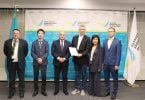KUALA LUMPUR (eTN) – Is there a case for “upping the value chain” in ecotourism? Or, should ecotourism remain a niche segment of the tourism industry that appeals only to “green” tourists?
About 250 delegates to the recent World Ecotourism Conference 2010 in Kuala Lumpur heard a healthy dose of arguments from academics arguing the future of ecotourism in “upping the value chain” if the industry is to retain its appeal.
Led by the “untiring efforts” of Professor Amran Hamzah from Universiti Teknologi Malaysia, researchers in ecotourism and tourism experts were given a global platform to present research works “for the betterment of sustainable tourism economies, people, and the environment.”
Supported by eTurboNews as an industry partner, industry practitioners examined the case for shifting paradigms as much as adapting to changing conditions in the industry. Delegates also looked at the impact of climate change, which remains an industry bugbear.
Declaring 2010 as the United Nation’s Year of Biodiversity, Dr. Taleb Rifai, UNWTO secretary-general appealed to ecotourism industry stakeholders from both the public and private sectors to strongly assess ecological impacts on the environment while acknowledging its role as a socio-economic driver.
“Embrace best practices in sustainable tourist development and rise as true champions of tourism and biodiversity, ” said Dr. Rifai in his message to delegates.
“If I am in it for the money, I will be doing something else,” argued industry practitioner Chan Yuen Li, whose Nomad Adventures has been certified as a Rescue 3 trainer. “I couldn’t even get a permit to conduct bungy jumping as an adventure sport.”
In her arguments for the increasing popularity of homestay tourism to push up tourism’s value chain, researcher Clotilde Luquiau from France claims, “As a characteristic, homestay tourism benefits the local people directly.”
In her study of homestay in Tanjung Piai, Johor, Haniza Mohamad from Universiti Teknologi Malaysia concludes the nature of a homestay program is to “employ and involve a large number of locals in its operations. It benefits the local economy.”
Citing her studies in the lower plains of Kinabatangan, Sabah, Luquiau said tourists like the experience of homestays.”They are eager to learn about the local culture, tradition, and share the everyday life of the people even if they had some criticisms. It is an eye-opener.”
Lamenting it is not an easy experience to translate on the Internet in today’s changing climate of marketing travel experiences, tourists are often confused between homestays and Bed & Breakfast experiences.
In her value chain analysis of Pro Poor Income (PPI) to measure the economic benefits received by homestay operators, Haniza cautioned, “Substantial profits from tourism activities does not necessarily translate to the site contributing substantially to the local economy.
“The program should be maintained and the products further developed due to its potential of producing significant return for participants. We use value chain analysis as a tool to measure economic benefits for the local people and reveal weak economic leakages.”
In his analysis of how Kerala state has become a model for responsible ecotourism development in India, P. J. Shyju said the state has become an “all season destination” by introducing a number of innovative tourism products, which includes wellness/health tourism, in addition to its current stable of natural and cultural attractions. “Kerala’s tourism is a brand among other Indian states, even internationally,” Shyju stated.
But in an argument against moving “up the value chain” of ecotourism as an income generator, Shyju said it has only benefited resort owners and homestay operators who have “good connections.”
The guests are mostly from the upper-income group, so they can charge more, with some resulting in excessive charges for room and food.
As a result of over commercialization and the lack of price control mechanism, the visitor is exploited. “Despite the efforts by officials, visitor dissatisfaction has led to misunderstandings,” Shyju continued. “Rather than conservation, it has resulted in visitor exploitation, over crowding, and lack of waste management.”
Rapid changes and climate change has altered the village people’s lifestyle. Instead of maintaining their traditional crops, land owners are converting to planting commercial crops.
Land values around lakes, forests, or other deemed scenic spots with enough tourist potential have gone up multiple times. “A man now can’t even earn enough to own a small house,” Shyju said.
Expectations from tourism earnings has blinded operators. Visitors, in fact, just want to have fun and excitement instead of a learning experience. Local authorities, said Shyju, are to blame for ignoring the needs of locals when a new tourist attraction is developed, other than raising expectations and befitting the business owners.
Touting Malaysia’s potential in ecotourism as a country with a varied ecosystem of biodiversity from mountain to sea, Zoha Azhal from the country’s ministry of natural resources and environment said Malaysia is one of the 12 mega-diverse countries in the world which is rich in fauna and flora.
A “tropical heaven of biodiversity,” Malaysia’s conservation efforts range from its entrance-free renowned national elephant conservation sanctuary in Kuala Gandah, tiger valley and world’s largest cow in Krau Wildlife Reserve, to Tioman Island marine park for diving and snorkeling sports.
Despite registering a healthy growth rate of 14 percent per annum since 2004, the country’s potential as an ecotourism destination, however, still suffers from lack of packaging and coordinated promotion.
“Connectivity, support services, and on-site facilities in some areas is still inadequate. Sites are not well-maintained, and there is a lack of trained personnel,” said Azhal. “Still, the ecotourism sector accounts for 5 percent of Malaysia’s income from tourism.”
Conference Convener, Lee Choon Loong, who has been the industry’s face in Malaysia as well as association secretary-general, claimed an industry first of including 10 “young eco warriors” from 9 countries, who he said had volounteered their involvement in organizing the conference at their own costs.
“Our success in attracting 48 speakers from 18 countries and delegates from 45 countries ensured the conference became a global success,” he said.
(eTN): Delegates examine case for upping the value chain at ecotourism conference | re-post license | post content






















